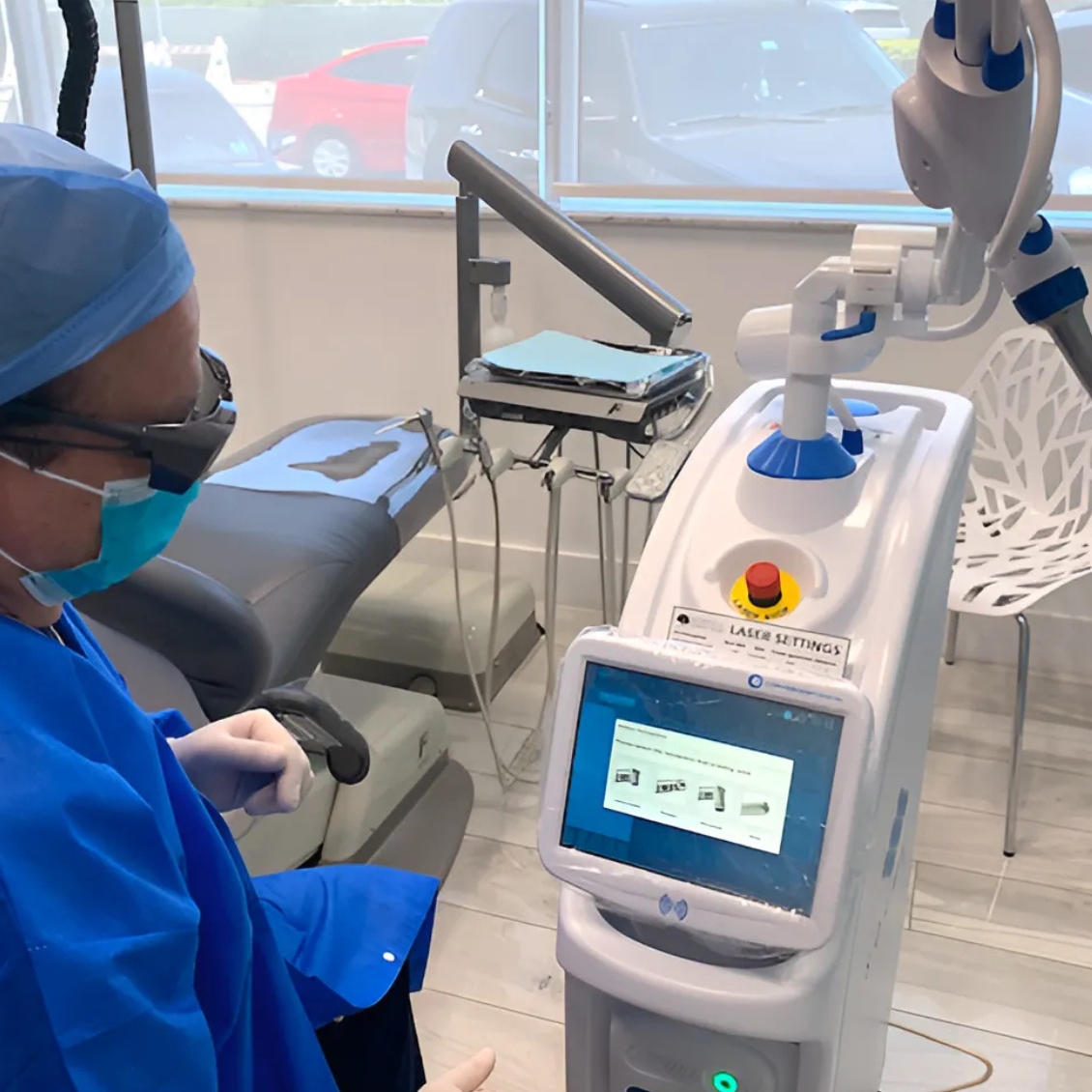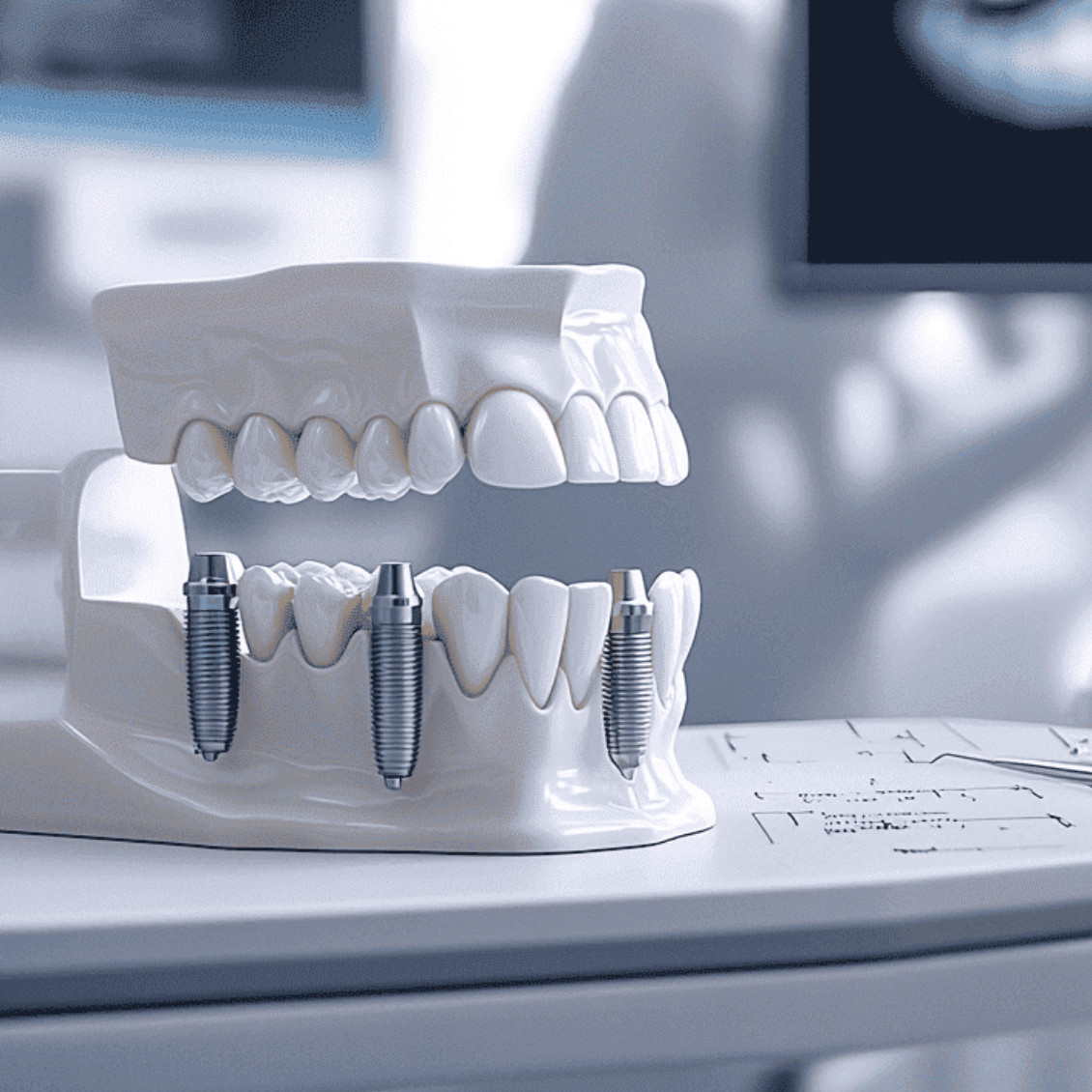From Fear to Freedom: How Solea Laser Technology Is Revolutionizing Pain-Free Dentistry
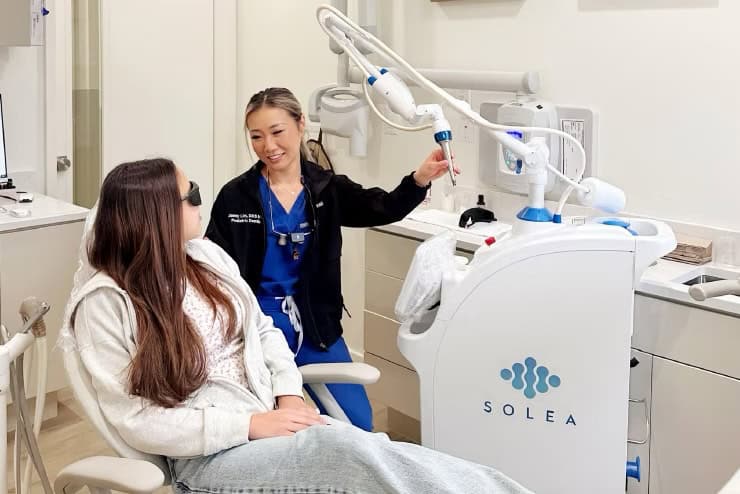
Discover how Solea Dental Laser technology is transforming anxiety-filled dental visits into comfortable, pain-free experiences while delivering superior clinical outcomes for procedures ranging from fillings to soft tissue surgeries.
The high-pitched whir of the dental drill. The sharp pinch of the anesthetic needle. The lingering numbness that turns lunch into an awkward, drooling affair. For millions of Americans, these sensations aren't just unpleasant—they're the foundation of dental anxiety so severe that necessary care is postponed or avoided entirely.
Dental fear isn't uncommon or irrational. In fact, approximately 36% of the population experiences dental anxiety, with 12% suffering from extreme dental fear. Behind these statistics are real people making decisions that ultimately compromise their health, all because traditional dental experiences have conditioned them to associate necessary care with unavoidable pain.
But what if everything you've come to expect about dental visits—the anxiety, the discomfort, the lingering numbness—could be fundamentally transformed? What if dental procedures could be performed with minimal to no pain, without needles, with little to no noise, and with significantly shorter recovery times?
This transformation isn't hypothetical—it's happening right now in dental practices across the country through revolutionary laser technology. Among these innovations, the Solea Dental Laser stands as a genuine paradigm shift in how dental care is delivered and experienced.
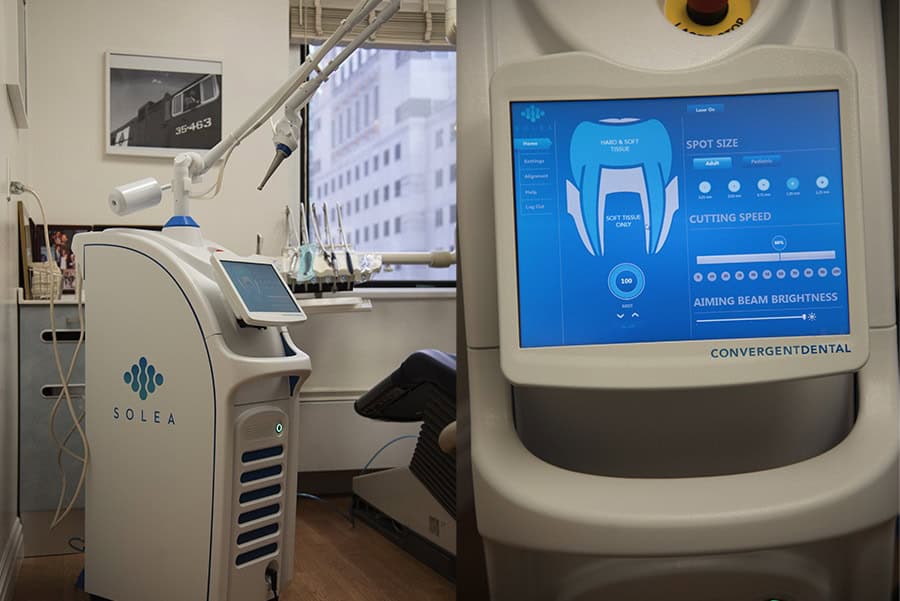
Understanding Solea Laser Technology: More Than Just Another Dental Tool
The Solea Dental Laser represents the culmination of decades of research and technological advancement in the field of laser dentistry. Unlike earlier dental lasers that showed promise but limited practical applications, Solea has emerged as the first truly versatile dental laser system capable of addressing both hard and soft tissue procedures.
At its core, Solea utilizes a unique wavelength (9.3 μm) CO2 laser technology that operates at a wavelength highly absorbed by both the hydroxyapatite in teeth and the water in soft tissue. This distinctive feature allows the laser to precisely cut through multiple tissue types with remarkable efficiency while simultaneously minimizing trauma to surrounding tissues.
The technology operates on fundamentally different principles than traditional dental tools. Rather than utilizing mechanical abrasion to remove tooth structure (as with a traditional drill) or sharp metal instruments to cut soft tissue, Solea employs precisely controlled pulses of light energy. These pulses vaporize targeted tissue with minimal transfer of heat or vibration to surrounding areas.
What truly distinguishes Solea is its proprietary computer-controlled system that allows for incredibly precise modulation of the laser energy. Think of it as having thousands of settings rather than just a few speeds like a traditional drill. This precision enables dentists to adjust the laser's parameters in real-time based on the specific tissue being treated and the particular requirements of the procedure.
The system's sophisticated handpiece provides dentists with exceptional control, allowing for cuts as precise as 30 microns—significantly smaller than the width of a human hair. This level of precision simply isn't possible with conventional dental instruments, creating opportunities for more conservative, tissue-preserving procedures.
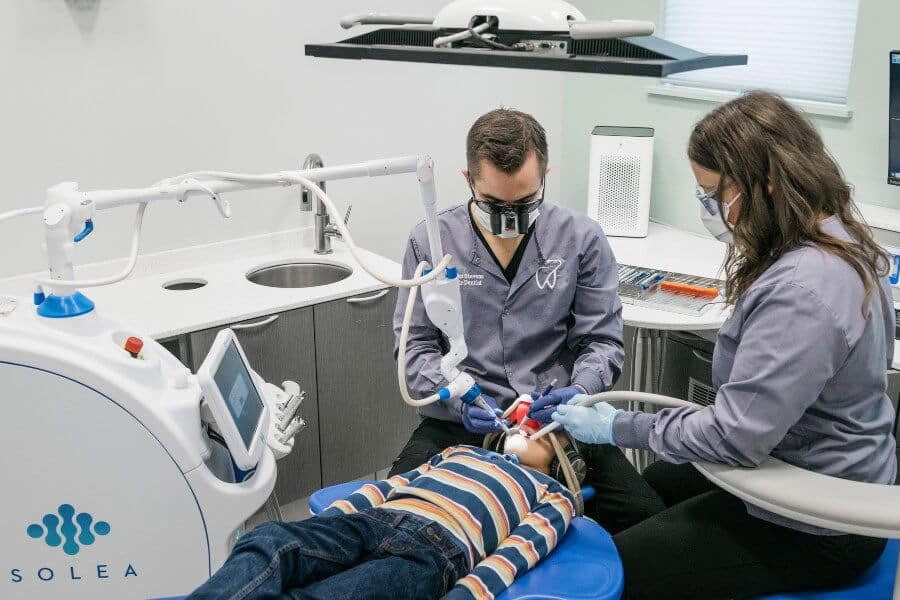
The Transformation of Dental Experiences: From Fear to Relief
The most immediate and profound benefit of Solea laser technology is its ability to perform many dental procedures without the need for anesthetic injections. For patients whose dental anxiety centers specifically around needles, this single advancement removes one of the most significant barriers to seeking care.
The reason Solea can often eliminate the need for anesthetic lies in how it interacts with dental tissues. Traditional drills generate heat, pressure, and vibration—all of which stimulate nerve endings and create pain signals. Solea's laser energy, by contrast, operates in microsecond pulses that are too fast for nerves to register as pain. Additionally, the laser has a natural analgesic effect that temporarily desensitizes the treatment area.
Even when some anesthetic might be beneficial for more extensive procedures, Solea significantly reduces the amount needed. Many patients find that topical anesthetic gel is sufficient, eliminating the discomfort and lingering numbness of injections. This means no more half-numb face, slurred speech, or accidental cheek biting for hours after a simple dental procedure.
Beyond anesthesia, Solea transforms the sensory experience of dental visits. The silence is perhaps the most striking difference—gone is the high-pitched whine of the drill that triggers anxiety responses in so many patients. Instead, Solea operates with minimal sound, producing only a gentle popping noise that most patients find far less distressing.
For those with sensitive teeth, the absence of pressure and vibration represents another significant improvement. Patients with tooth sensitivity often experience intense discomfort from traditional drilling, even with anesthesia, as the mechanical pressure stimulates nerve endings. Solea's non-contact approach eliminates this source of discomfort entirely.
The benefits extend beyond the procedure itself into recovery. Traditional dental tools can create microscopic fractures in tooth structure and traumatize surrounding soft tissues, leading to post-operative sensitivity and prolonged healing times. Solea's precise, minimally invasive approach significantly reduces these collateral effects, resulting in less post-procedure discomfort and faster recovery.
Beyond Comfort: Clinical Advantages of Solea Laser Dentistry
The advantages of Solea technology extend far beyond patient comfort, though that alone would justify its adoption. From a clinical perspective, this advanced laser system enables dental practitioners to provide treatment that is not just more comfortable but often superior in quality and long-term outcomes.
In restorative dentistry, Solea allows for unprecedented precision in cavity preparation. The laser can selectively remove decayed tooth structure while preserving healthy tissue, allowing for more conservative preparations that maintain the structural integrity of the tooth. This precision translates to stronger restorations with longer lifespans.
The technology's inherent precision also creates cleaner margins for fillings and other restorations. Traditional drills can create micro-fractures along the edges of preparations, potentially compromising the seal between restoration and tooth structure. Solea's laser energy creates smoother, more defined margins without these micro-fractures, potentially improving the longevity of restorations.
Perhaps most significantly, Solea's technology enables procedures that simply wouldn't be possible or practical with conventional tools. For example, the laser can effectively treat early-stage decay without removing significant tooth structure—an approach sometimes called "minimally invasive dentistry" that preserves natural teeth more effectively than traditional methods.
For soft tissue procedures, Solea's advantages become even more apparent. The laser naturally coagulates as it cuts, significantly reducing bleeding and improving visibility during procedures. This coagulation effect also eliminates the need for sutures in many cases, simplifying procedures and improving patient comfort during healing.
Infection risk is another area where laser technology demonstrates clinical superiority. The high-energy laser naturally sterilizes as it works, reducing bacterial counts in the treatment area and potentially lowering the risk of post-operative infections. This benefit is particularly valuable for patients with compromised immune systems or other factors that might increase infection risk.
Applications Across the Spectrum of Dental Care
One of Solea's most remarkable attributes is its versatility across virtually all dental disciplines. Unlike earlier dental lasers that might excel at soft tissue but struggle with hard tissue (or vice versa), Solea provides exceptional results across the full spectrum of dental procedures.
For general dentistry, Solea transforms routine filling procedures. Cavities can be prepared quickly and comfortably, often without anesthesia, and with greater preservation of healthy tooth structure. The laser's precision allows dentists to remove only the decayed portion while leaving healthy enamel and dentin intact—a level of conservation difficult to achieve with traditional drills.
In pediatric dentistry, Solea's benefits become even more pronounced. Children's dental anxiety can establish patterns that last a lifetime, so providing positive, pain-free experiences early can fundamentally change their relationship with dental care. The absence of needles, drilling sounds, and pressure makes procedures significantly less frightening for young patients. Additionally, the elimination of post-procedure numbness prevents the accidental cheek or lip biting that frequently occurs when children leave the dental office with anesthesia still active.
For periodontal therapy, Solea enables treatments that combine remarkable effectiveness with minimal discomfort. The laser can selectively remove diseased tissue from periodontal pockets while stimulating healthy attachment, promoting more effective healing than traditional scaling and root planing alone. The natural sterilization effect of the laser energy can reduce bacterial loads in periodontal pockets, potentially improving treatment outcomes.
In cosmetic dentistry, Solea provides unparalleled precision for gingival contouring and other soft tissue procedures that enhance smile aesthetics. The laser can reshape gum tissues with minimal bleeding and exceptional healing, creating more balanced gingival contours and improving the appearance of "gummy" smiles. The precision of these contours often exceeds what's possible with traditional surgical approaches.
For oral surgery, Solea simplifies procedures from frenectomies to biopsies. The reduced bleeding, elimination of sutures in many cases, and significantly improved healing make these procedures less invasive and more comfortable. Patients typically experience less post-operative pain and swelling, with shorter recovery periods compared to traditional surgical approaches.
The Human Impact: Changing Relationships with Dental Care
The technical benefits of Solea technology are impressive, but its most profound impact may be in how it transforms patients' relationships with dental care. For many individuals, particularly those with significant dental anxiety, Solea represents not just a more comfortable procedure but a fundamental shift in how they perceive dental visits.
Consider the experience of dental anxiety sufferers. These individuals often enter a cycle where fear leads to avoidance, avoidance leads to worsening dental conditions, and those conditions ultimately require more invasive treatment—which reinforces the original fear. This cycle can persist for decades, compromising not just oral health but overall wellbeing.
Solea technology has the potential to break this cycle by providing genuinely different experiences. Imagine a patient with severe dental anxiety who needs a cavity filled. With traditional methods, they might postpone treatment until pain becomes unbearable, require significant sedation to tolerate the procedure, and leave with reinforced negative associations.
With Solea, the same patient might be surprised to discover they can undergo treatment without needles or drilling sensations. The procedure finishes more quickly, they leave without numbness, and most importantly, they develop a new reference point for dental care—one not defined by pain or fear.
For patients with medical conditions that complicate traditional dental care, Solea can be especially transformative. Those on blood thinners, for instance, benefit from the laser's hemostatic properties that reduce bleeding concerns. Patients with certain neurological conditions who struggle with the sensory aspects of traditional dental treatment often find Solea's approach more tolerable.
Parents frequently report that their children's attitudes toward dental visits change dramatically after experiencing Solea treatment. Without the frightening experiences that traditionally define dental care, children develop healthier relationships with oral healthcare that can persist throughout their lives.
The Evolution of Dental Practice: What to Expect
As Solea and similar advanced technologies become more widespread, patients can expect continuing evolution in how dental care is delivered. These changes extend beyond the technical aspects of treatment to encompass the entire dental experience.
One notable shift is toward single-visit treatment of multiple areas. Traditional dentistry often requires treating just one quadrant of the mouth per visit, primarily because of anesthesia limitations. With Solea's anesthesia-free approach, dentists can often treat multiple quadrants or even the entire mouth in a single appointment, dramatically reducing the number of visits needed to complete treatment plans.
Treatment scheduling is becoming more flexible as well. Without the need to account for anesthesia recovery, appointments can be scheduled during lunch breaks or other short time windows, making dental care more accessible for busy professionals. This flexibility removes another barrier to regular care for many patients.
The patient experience itself is evolving to emphasize comfort and control. Many Solea providers have adopted protocols that give patients signal methods to pause treatment if needed, helping anxious individuals feel more in control of their experience. This psychological aspect of care can be as important as the physical comfort improvements the technology provides.
From a practice perspective, dental offices equipped with Solea technology can often provide a wider range of services in-house rather than referring to specialists. This comprehensive care approach allows for better continuity and coordination of treatment, ultimately benefiting patients through more cohesive care plans.
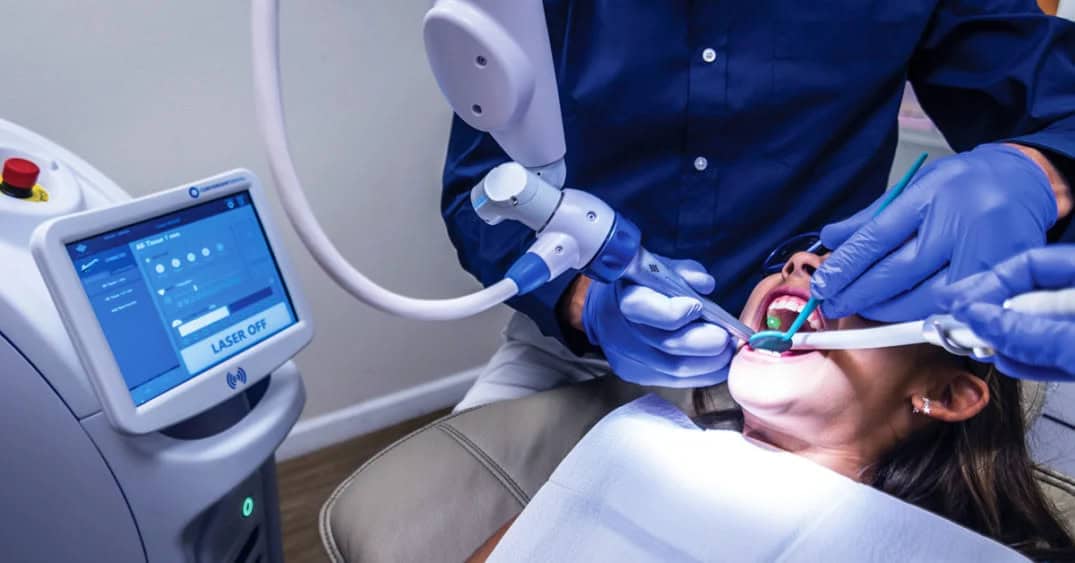
Is Solea Laser Dentistry Right for You?
While Solea technology offers remarkable benefits, patients naturally want to know if it's appropriate for their specific needs and concerns. Understanding who might benefit most from this approach can help inform conversations with dental providers.
Those with dental anxiety or dental phobia stand to gain the most obvious benefits from Solea treatment. The elimination of many anxiety triggers—needles, drilling sounds and sensations, prolonged numbness—directly addresses the factors that make dental visits distressing for these individuals.
Patients with sensitive teeth often find Solea treatment particularly valuable. The non-contact approach eliminates the pressure and vibration that can trigger sensitivity with traditional instruments, making procedures more comfortable even for those with extremely sensitive dentition.
Individuals with busy schedules appreciate Solea's efficiency advantages. Procedures typically take less time to complete, and the absence of post-procedure numbness means immediately returning to work or social activities without speech or eating limitations.
Those requiring extensive dental work may find Solea's approach allows them to complete comprehensive treatment plans more comfortably and with fewer visits. The ability to treat multiple areas in a single appointment can significantly shorten the timeline for full-mouth rehabilitation.
Children and adolescents often respond especially well to Solea treatment. Beyond the comfort advantages, the technology's speed allows for completing procedures before young patients reach their cooperation limits, improving both the experience and the quality of outcomes.
It's worth noting that while Solea is remarkably versatile, certain complex procedures may still require traditional approaches or combined techniques. A thorough consultation with a Solea-equipped provider can determine the most appropriate treatment approach for specific conditions.
The Future of Dental Comfort: Looking Forward
As Solea technology continues to evolve and integration with other dental innovations progresses, patients can expect even more significant improvements in dental experiences. The current capabilities, impressive as they are, represent just the beginning of laser dentistry's potential.
Ongoing research and development are focusing on expanding Solea's applications to address an even wider range of dental conditions. Researchers are exploring enhanced protocols for treating advanced periodontal disease, simplified approaches to endodontic therapy, and novel applications in implant dentistry.
Integration with digital dentistry represents another frontier. As Solea technology becomes more seamlessly incorporated with digital scanning, CAD/CAM systems, and 3D printing, the potential for truly comprehensive single-visit dentistry continues to expand.
For patients, the most meaningful development may be the increasing accessibility of this technology. As more dental practices adopt Solea systems and dentists become increasingly skilled in laser techniques, more patients will have the opportunity to experience truly pain-free, anxiety-free dental care.
Ultimately, the promise of Solea and similar technologies extends beyond simply improving existing dental procedures. These innovations have the potential to fundamentally change how we think about oral healthcare—transforming it from something many people fear and avoid into care that can be received comfortably, efficiently, and without anxiety.
Embracing a New Dental Experience
The journey from fear to relief in dental care represents more than just technological advancement—it reflects a deeper understanding of the human experience of healthcare. Solea laser technology acknowledges that physical comfort and emotional wellbeing are inseparable aspects of truly effective care.
For patients who have postponed necessary treatment due to anxiety or past negative experiences, Solea offers a compelling reason to reconsider. The technology directly addresses the sources of dental fear, providing an experience fundamentally different from traditional approaches.
For those without significant dental anxiety, Solea still offers meaningful advantages in efficiency, precision, and overall comfort that can enhance the care experience. Even routine procedures become noticeably more pleasant when performed with this advanced approach.
If you've been delaying dental treatment due to anxiety, sensitivity concerns, or time constraints, consider consulting with a dentist who offers Solea laser technology. Many providers offer no-obligation consultations where you can learn more about how this approach might benefit your specific situation.
The transformation from fearful avoidance to comfortable engagement with dental care represents more than just improved oral health—it can enhance quality of life by removing a significant source of stress and anxiety. With Solea laser technology, dental care can finally become what it always should have been: effective, efficient, and genuinely comfortable.
The dental experience you've always hoped for—one without pain, anxiety, or lengthy recovery—isn't just possible. With Solea technology, it's becoming the new standard of care.
Frequently Asked Questions About Solea Laser Dentistry
Is laser dentistry truly pain-free?
While individual experiences vary, most patients report significantly less discomfort with Solea laser treatment compared to traditional methods. The laser's unique properties allow it to interact with dental tissues without triggering pain responses in many cases. For the majority of procedures, patients experience little to no pain, often eliminating the need for anesthetic injections entirely. Even in more complex cases where some anesthesia might be beneficial, the amount required is typically much less than with conventional approaches. The absence of drilling vibration, pressure, and noise also contributes to a more comfortable overall experience.
Is Solea laser treatment safe for all patients?
Solea laser technology has been cleared by the FDA and has an excellent safety profile for dental procedures. The system is designed with multiple safeguards to protect both patients and practitioners. It's generally appropriate for patients of all ages, from children to seniors. In fact, certain populations who might face challenges with traditional dentistry—such as children, anxious patients, or those with certain medical conditions—often benefit most from this gentle approach. As with any treatment, your dentist will evaluate your specific situation to determine if Solea is the optimal approach for your needs.
How much more expensive is laser dentistry compared to traditional methods?
The cost of Solea laser treatment varies depending on the specific procedure, your location, and your dental provider. Some practices include laser technology as part of their standard care without additional charges, while others may have modest fee differences to offset the significant investment in advanced technology. Many patients find that any potential cost difference is offset by the benefits: fewer appointments needed due to the ability to treat multiple areas in one visit, less time away from work, and the value of a more comfortable experience. Insurance coverage for laser procedures typically matches coverage for traditional approaches, as the treatments address the same conditions with improved methodology.
What types of dental procedures can be performed with Solea?
Solea's versatility is one of its most remarkable features. The system can be used for an exceptionally wide range of dental procedures including cavity preparations, crown and veneer preparations, gingival recontouring, frenectomies, fibroma removals, aphthous ulcer treatments, exposure of impacted teeth, removal of diseased tissue in periodontal pockets, and many more applications. It effectively treats both hard tissues (teeth) and soft tissues (gums and oral mucosa), often allowing dentists to provide comprehensive care using a single instrument. This versatility frequently means patients can have multiple procedures completed in a single visit rather than requiring separate appointments.


